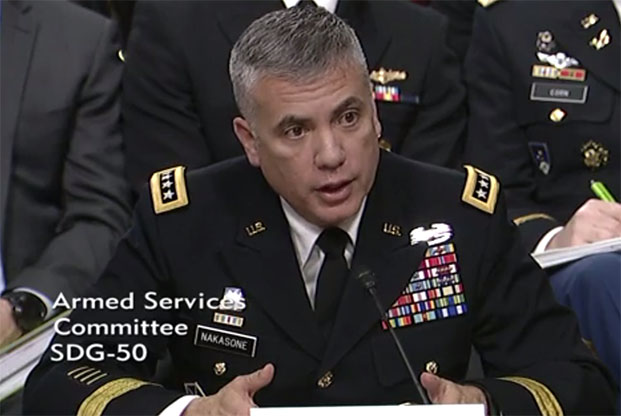
Army Gen. Paul Nakasone, commander of US Cyber Command and director of the National Security Agency, testified before the Senate Armed Services Committee on Feb. 14, 2019. SASC screenshot.
US Cyber Command views its existing cadre of cyber warriors as a starting point for growth as the Pentagon pivots to compete with more tech-savvy adversaries, the command’s top general told lawmakers Thursday.
Army Gen. Paul Nakasone, who also directs the National Security Agency, said at a Senate Armed Services Committee hearing he expects to need more people to conduct operations as adversaries improve. The US is chiefly concerned about mounting threats from Russia, China, North Korea, Iran, and some non-state actors.
“As we measure our readiness against what we consider a number of different adversaries, primarily both near-peer and rogue states, we believe that the teams that we’ve created right now is the building block for that,” Nakasone said. “We are also … building a series of defensive teams in the Army Reserve and the National Guard that are going to be a strategic depth for us.”
He declined to answer questions following the hearing.
After some delays, the Pentagon finished creating 133 Cyber Mission Force teams with members from all three services last year. While the Defense Department has other groups that also wage offensive and defensive cyber operations, the new teams report directly to CYBERCOM and reflect the government’s recent embrace of network combat.
More than 6,200 soldiers, sailors, airmen, Marines, and civilians tackle four missions as part of the Cyber Mission Force, according to the Pentagon. Cyber national mission teams find enemy activity, block their attacks, and defeat them. Cyber combat mission teams supply cyber operations for combatant commanders around the world. Cyber protection teams defend DOD networks, are assigned to “priority” missions, and prepare offensive cyber forces for combat. Cyber support teams provide analysis and planning support to national and combat mission teams.
The challenge, Nakasone said, is to retain the best of the best — those he calls “10 or 20 x type of people” because they are 10 and 20 times better than their cohorts at developing software, analyzing malware and coding.
As cyber warfare evolves, Nakasone and other cyber officials have lobbied Congress for more leeway to pursue bad actors without bureaucratic constraints.
Thanks to the Fiscal 2019 National Defense Authorization Act, CYBERCOM can now rapidly deploy resources to the Department of Homeland Security, with which it partners on a range of issues like energy infrastructure security. Pentagon staff are considering the best way to share cybersecurity information with other government agencies, whether through planned meetings or only as needed.
“We have put into place within the Department of Defense a pathfinder program to look at this element, and so we’ve established a regular meeting with the sector security agent, which is the Department of Energy, working with them and the Department of Homeland Security to share that information regularly,” Nakasone said.
The military is allowed to analyze non-DOD networks as well.
Additional cyber infrastructure, sensors, and capabilities will help the US stay one step ahead as it builds its digital warfare enterprise, Nakasone said. He also stressed the importance of good cyber hygiene and software security standards to lessen the chance that others could take advantage of US networks.
“Our most important thing right now is to be able to enable our partners, whether or not those partners are joint force commanders in cyberspace or those partners are other members of the interagency,” Nakasone said. “Our work with the Department of Homeland Security and the Federal Bureau of Investigation is an exemplar, I think, of the enabling aspect that we will do against near-peer competitors.”
